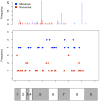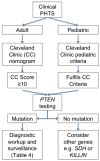Lifetime cancer risks in individuals with germline PTEN mutations
- PMID: 22252256
- PMCID: PMC3261579
- DOI: 10.1158/1078-0432.CCR-11-2283
Lifetime cancer risks in individuals with germline PTEN mutations
Abstract
Purpose: Age-adjusted cancer incidence and age-related penetrance studies have helped guide cancer risk assessment and management. PTEN hamartoma tumor syndrome (PHTS) is a term encompassing subsets of several clinical syndromes with germline mutations in the PTEN tumor suppressor gene. We conducted the first prospective study to clarify corresponding cancer risks to shed biologic insights on human germline PTEN mutations, and to better inform current surveillance recommendations on the basis of expert opinion.
Experimental design: A series of 3,399 individuals meeting relaxed International Cowden Consortium PHTS criteria were prospectively recruited; 368 individuals were found to have deleterious germline PTEN mutations. Age-adjusted standardized incidence ratio (SIR) calculations and genotype-phenotype analyses were carried out.
Results: Elevated SIRs were found for carcinomas of the breast [25.4, 95% confidence interval (CI), 19.8-32.0], thyroid (51.1, 38.1-67.1), endometrium (42.9, 28.1-62.8), colorectum (10.3, 5.6-17.4), kidney (30.6, 17.8-49.4), and melanoma (8.5, 4.1-15.6). Estimated lifetime risks were, respectively, 85.2% (95% CI, 71.4%-99.1%), 35.2% (19.7%-50.7%), 28.2% (17.1%-39.3%), 9.0% (3.8%-14.1%), 33.6% (10.4%-56.9%), and 6% (1.6%-9.4%). Promoter mutations were associated with breast cancer, whereas colorectal cancer was associated with nonsense mutations.
Conclusion: Lifetime risks for a variety of cancers, now extending to colorectal cancer, kidney cancer, and melanoma, are increased in patients with PTEN mutations. The genotype-phenotype associations here may provide new insights on PTEN structure and function. We propose a comprehensive approach to surveillance of patients with PTEN mutations.
©2011 AACR.
Conflict of interest statement
Conflict of interest disclosure: The authors have no conflict of interest to declare
Figures



Comment in
-
Lifetime cancer risks of PTEN mutation carriers--letter.Clin Cancer Res. 2012 Aug 1;18(15):4213; author reply 4214. doi: 10.1158/1078-0432.CCR-12-0577. Epub 2012 Jun 21. Clin Cancer Res. 2012. PMID: 22723373 No abstract available.
References
-
- Li DM, Sun H. TEP1, encoded by a candidate tumor suppressor locus, is a novel protein tyrosine phosphatase regulated by transforming growth factor beta. Cancer Res. 1997;57:2124–9. - PubMed
-
- Gorlin RJ, Cohen MM, Jr, Condon LM, Burke BA. Bannayan-Riley-Ruvalcaba syndrome. Am J Med Genet. 1992;44:307–14. - PubMed
-
- Hobert JA, Eng C. PTEN hamartoma tumor syndrome: an overview. Genet Med. 2009;11:687–94. - PubMed
-
- Nelen MR, Padberg GW, Peeters EA, Lin AY, van den Helm B, Frants RR, et al. Localization of the gene for Cowden disease to chromosome 10q22-23. Nat Genet. 1996;13:114–6. - PubMed
Publication types
MeSH terms
Substances
Grants and funding
LinkOut - more resources
Full Text Sources
Medical
Research Materials

